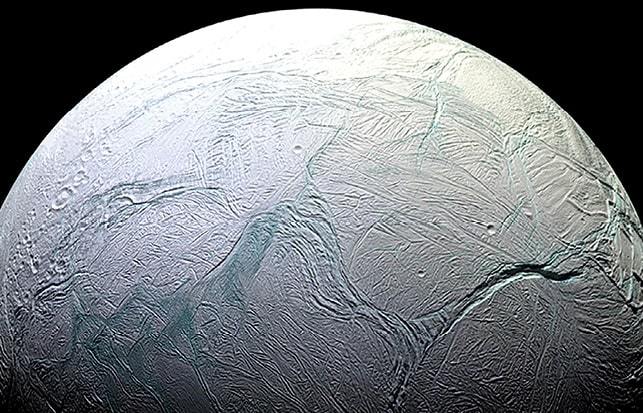The globe-spanning ocean on Saturn’s icy moon Enceladus, which is believed to be at least 30 kilometres deep, could be swirling around in currents like those found on Earth say scientists in a new study; a finding which one day could help narrow down the search for life on this compelling world.
Despite being only 500 kilometres in diameter and with the most reflective body in the solar system due to its thick covering of ice, Saturn’s sixth-largest moon, Enceladus, is one of the few places in our cosmic back yard where life could be present.
It’s status as a potential habitable world was boosted, when in 2008 NASA’s Cassini mission sampled material expelled into space by jets shooting out from Enceladus’ ocean at 400 metres per second (800 miles per hour).
The material, which forms a plume that extends hundreds of kilometres into space, was a mixture of water and simple organic chemicals and pointed to the existence of an underground ocean with unique chemistry and internal heat.
This deep ocean was thought to be homogenous and didn’t move around much except for some vertical mixing driven by the warmth of the moon's core.
This also meant that the top of the ocean near the ice shell would be cooler – attributes that were in stark contrast to Earth’s ocean which is warmer at the top from the sun's rays and colder in the depths near the seafloor.
Enceladus also has another curious feature - ice at its poles is thinner than at it’s equators; an attribute discovered by gravitational measurements and heat calculations from Cassini, which flew by the tiny frozen ball for the last time in October 2015.
Using their knowledge of ice and water interactions to drive ocean mixing around Antarctica, a team of researchers headed by Caltech graduate student Ana Lobo, and Andrew Thompson, professor of environmental science and engineering, ran a number of computer models to try and simulate why this might be the case.
Their results indicated that a salt-laden churning current from pole to equator could account for the ice structure seen on Enceladus.
Salt water can effect ocean current when it freezes, as it releases the salts, making the surrounding water heavier, causing it to sink. The opposite happens in regions of melt.
If Enceladus had churning oceans akin to those on Earth, a pole-to-equator circulation would influence the distribution of heat and nutrients causing regions of thin ice at the poles due to melting and regions of thick ice at the equator due to freezing.
This was the same behaviour predicted in the teams models and backed up by the earlier data gathered by Cassini.
"Knowing the distribution of ice allows us to place constraints on circulation patterns," Lobo explains.
Whats more, it also helps scientists understand which regions of the subsurface ocean might be the most hospitable to life and could one day inform efforts to search for signs of life, Thompson concluded.
These findings, entitled, "A pole-to-equator ocean overturning circulation on Enceladus,” have been published this week in Nature Geoscience.











